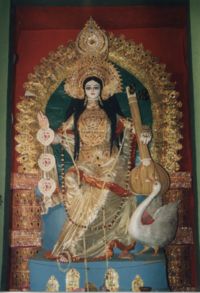| Vasant Panchami |
|---|

|
| Official name | Vasant Panchami |
|---|
| Also called | Shree Panchami
Saraswati Puja |
|---|
| Observed by | Hindus and Sikhs |
|---|
| Liturgical Color | Yellow |
|---|
| Observances | Puja and social functions |
|---|
| Date | Magha Shukla Panchami |
|---|
| 2014 date | 4 February |
|---|
| 2015 date | 24 January[1] |
|---|
For Sikhs, in the Harmandir Sahib, Amritsar, on the day of Vasant Panchmi, musicians start the music by singing Basant Raga. This practice continues up until the first day of Vaisakh when Basant Rag is no longer used.
[3] A fair normally held at the famous Sikh shrine of Guru-ka-Lahore in
Bilaspur district to mark the occasion of the marriage of Guru Gobind Singh Ji on Vasant Panchami.
Occurrence[edit]
Vasant Panchami is the first and more minor of two spring-themed festivals in Hindu culture. Vasant Panchami initiates the spring festive cycle and heralds its summation that occurs with
Holi.
[4] The seasonal aspects of the festival are more significant in
Northern India due to the sharper contrast between the winter and the spring,
[5] however the festival's religious and cultural significance are emphasized across all celebrating regions. In ancient
Indian literature, Vasant Panchami is associated with
Shringara Rasam and the festival was celebrated in this tradition.
[6] Celebrations today still honor
Kamadeva, his wife
Rati, and his friend Vasant (the personification of Spring).
[7]
In modern times, however, Vasant Panchami day is more commonly associated with Maa
Saraswati, the goddess of learning, wisdom, knowledge, fine arts, refinement, science and technology.
[7] Goddess Saraswati is worshipped and the day is treated by celebrants as Saraswati's birthday.
[4]People worship Goddess Saraswati to attain enlightenment through knowledge and to rid themselves of lethargy, sluggishness and ignorance.
Vasant Panchami is celebrated every year on the fifth day of the bright half of the Indian month of
Magh (spring season, January to February).
[6][7][8] It is celebrated as Saraswati Puja primarily over
eastern parts of India, and as Sri Panchami in other parts of
Bengal.
[7] In the
Punjab region, Basant is celebrated as the
Basant Festival of Kites: kite festivals are held in cities such as
Firozpur.
[5] In terms of its cultural significance, the festival has been compared to
Chinese New Year and the Christian
Candlemas, with the subsequent 40-day stretch between Vasant Panchami and Holi compared to the Christian
Lenten season.
[4]
Traditions[edit]
During the ancient period when Vasant Panchami was more oriented toward Kamadeva, dancing girls,
dhol players, and other celebrants would come to the royal Bakshi's palace to create an informal
durbar with the royals. Specially made Vasanti clothes would be worn by the dancing girls and younger royal ladies, consisting of a skirt, blouse, and pink or saffron
sari with tiny red square or circular dots. This clothing would be further embellished with gold and silver borders and
brocade work. On the celebration day the dancing girls would collect flowers and
mango leaves (a reference to one of the love-arrows of
Kama Dev) from the garden of the Bakshi's palace. The flowers and mangoes were arranged in brass vessels and the informal durbar would be set up. The occasion was marked by the singing of various
ragas usually on the theme of love (especially songs involving
Krishna and
Radha or the
gopies of
Brij Bhoomi). At the conclusion of the celebration, the flowers would be sprinkled with red gulal and the dancing girls would apply it to their cheeks. They were then gifted a sum of money by the royal ladies.
[6] Today this is not practiced, and the festival is oriented toward
Sarasvati, however Kamadeva remains an important figure as feasts are held in his honor during Vasant Panchami,
[7] and the theme of love remains an important part of the festival with this being the most popular day of the year for weddings in some areas.
[4]

Idol of Saraswati for puja in
Kolkata, 2000
The day before Vasant Panchami in
Nepal, Sarasvati's temples are filled with food so that she can join the celebrants in the traditional feasting the following morning.
[4] In temples and educational institutions, statues of Sarasvati are dressed in yellow and worshiped.
[4] Most educational institutions arrange special prayers or pujas in the morning to seek blessing of the Goddess. Poetic and musical gatherings are held and children are initiated to learn the alphabet
[7] and are often taught to write their first words.
[4] This ritual of initiating education to children is known as Akshar-Abhyasam or Vidya-Arambham/Praasana, one of the famous rituals of Vasant Panchami. Older students clean their pens and inkwells but abstain from reading or writing on this day.
[4]In Bengal, idols of Saraswati are taken on procession and immersed in the holy
Ganga.
[7]
The color yellow plays an important role in Vasant Panchami as it is related to the bloom of mustard flowers during this period.
[5] Celebrants usually wear yellow garments,
[7] Saraswati is worshiped in a yellow dress,
[4] and sweet
saffron rice[7] and yellow
sweets are consumed within the families.
[4]
Other associated rituals include the invitation of
Brahmin to join in the lunch feast, and the performance of ancestor worship (
Pitr-tarpan). In the
Punjab region,in areas such as
Firozpur, children generally fly kites to mark the auspicious occasion. This has led to the festival being called the Festival of Kites or the Kite Festival.
[5] Children buy
Dor (Thread) and
Guddi or "Patang" (Kites) in huge quantities to fly overhead. This attracts tourism from around the world. In places such as Balarama temple in Baithain, the singing of
Holi songs and the throwing of color begin on Vasant Panchami and continue throughout the Holi season.
[8]
The 40-day period between Vasant Panchami and Holi corresponds with the 40 days of
Rati's penance after her husband,
Kamadeva was reduced to ashes for shooting the eye of
Shiva with his love arrows. Between Vasant Panchami and Holi, preparations are made for numerous burnings in effigy of the demoness
Holika. Starting on Vasant Panchami, a log with a figure of Holika is placed in a public place and during the next 40 days, the faithful add twigs and other combustible material to the log to form a pyre which is lit on Holi.
[4]
Etymology[edit]
Vasant Panchami has a specific meaning:
Vasant means "spring,"
[4][7] and
Panchami means "the fifth day."
[4] Vasant Panchami falls on the fifth day of spring.
Overseas Celebrations[edit]
The festival is celebrated by the Indian diaspora based at
Nottingham, UK, every year under the aegis of the socio-cultural group
Jhankar-NICA.
[9]
References[edit]
- "Vasant Panchmi", a book by Anurag Basu.
- "Kite Festival" by Sanjeev Narula.




 Sikhism portal
Sikhism portal Indian religions portalVasant Panchami (Template:Sanskrit language Hindi: वसन्त पञ्चमी), orBasant Panchami, sometimes referred to as Saraswati Puja (Bengali language:সরস০বতী পূজা, Oriya language:ସରସ୍ୱତୀ ପୂଜା), Shree Panchami, or theBasant Festival of Kites is a Sikh and Hindu festival held on the fifth day ofMagha (in early February) marking the start of spring and the Holi season. On this day Hindus worship Saraswati Devi, the goddess of knowledge, music, art and culture.For Sikhs, in the Harmandir Sahib, Amritsar, on the day of Vasant Panchmi, musicians start the music by singing Basant Raga. This practice continues up until the first day of Vaisakh when Basant Rag is no longer used.[3] A fair normally held at the famous Sikh shrine of Guru-ka-Lahore in Bilaspur district to mark the occasion of the marriage of Guru Gobind Singh Ji on Vasant Panchami.
Indian religions portalVasant Panchami (Template:Sanskrit language Hindi: वसन्त पञ्चमी), orBasant Panchami, sometimes referred to as Saraswati Puja (Bengali language:সরস০বতী পূজা, Oriya language:ସରସ୍ୱତୀ ପୂଜା), Shree Panchami, or theBasant Festival of Kites is a Sikh and Hindu festival held on the fifth day ofMagha (in early February) marking the start of spring and the Holi season. On this day Hindus worship Saraswati Devi, the goddess of knowledge, music, art and culture.For Sikhs, in the Harmandir Sahib, Amritsar, on the day of Vasant Panchmi, musicians start the music by singing Basant Raga. This practice continues up until the first day of Vaisakh when Basant Rag is no longer used.[3] A fair normally held at the famous Sikh shrine of Guru-ka-Lahore in Bilaspur district to mark the occasion of the marriage of Guru Gobind Singh Ji on Vasant Panchami.
पेड़ और पौधों अपनी पुरानी पंक्तियों को बाहर छोड़ देते हैं और वसंत के महीने में यह नए-नए पंक्ति उत्पन्न करते हैं प्राकृतिक इन चरणों के दौरान अपने सबसे सुंदर रूप को धारण करता है क्योंकि वसंत पंचमी वसंत के आगमन का प्रतीक है इसीलिए यह त्यौहार बड़ी ही पैमाने पर कवियों विचार को प्राकृतिक प्रेमियों और लोगों की कल्पना को जानने की लिए है
ReplyDeletevasant panchami 2021